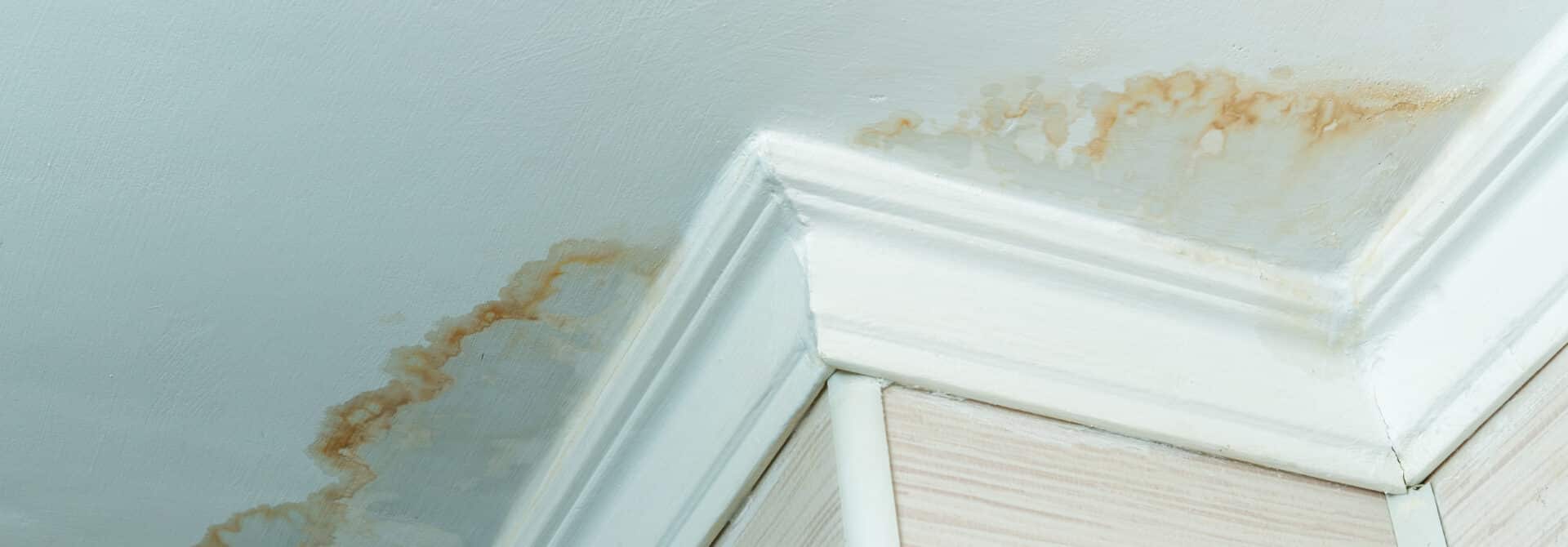
Can You Paint Over Water Stains?
A wall that’s riddled with water stains is a wall no one wants to look at in their home. Not only is it unsightly, but it could cause some serious structural damage if it isn’t taken care of in a timely fashion. If you’re scrambling to find a solution to the water stains you have on your property, you may be asking yourself: can you paint over water stains?
The quick answer to this is yes. But there are some key things you need to address before you even think about whipping out your paintbrushes.
How Do Water Stains on Ceilings and Walls Happen?
Water stains on ceilings and walls are typically a telltale sign of water damage. They can manifest as discolored patches, often appearing brown or yellow, and may vary in size and severity. Understanding how these stains happen in the first place is crucial to effectively addressing the underlying issue.
Water damage can be caused by several different things, including:
- Leaky Roof: A damaged or improperly installed roof can allow water to seep into your home.
- Burst Pipes: This one is especially prevalent during the colder months. Frozen or corroded pipes can burst and quickly cause water damage and water stains.
- Faulty Appliances: Appliances like dishwashers, washing machines, or water heaters can develop leaks, which can then seep onto the floor or into the walls of your home.
- Natural Disasters: Events like hurricanes and snowstorms can all bring excess water into your home.
- HVAC Units: Heating, ventilation, and air-conditioning systems within your home can cause floods if they haven’t been inspected or cleaned on a regular basis.
- Clogged Gutters: Your home’s gutter system is designed to draw rainwater away from your home. But gutters can get clogged up with leaves, branches, and other kinds of debris over time. When this happens, the rainwater can’t flow properly and will instead overflow, causing water damage to your walls or ceilings.
These are just a handful of ways water stains can occur in your home.
So, Can You Paint Over Water Stains?
Yes, you can paint over water stains, but it’s crucial to address the underlying issue first. Simply painting over the stain without fixing the source of the water damage will likely result in the stain bleeding through the new paint, which means you’ll have to re-do all your hard work. This can quickly get expensive, and you could be unknowingly causing further structural damage to your home. Thus, before you start painting, make sure you’ve identified and fixed the root cause of the water damage.
5 Tips on How to Paint Over Water Stains
At Paint Denver, we have a wealth of experience in all things painting–and that includes painting over water stains in our clients’ homes. Here’s a step-by-step guide to getting it done:
- Inspect and Repair: Before you start painting, make sure to identify the cause of the water damage and get it repaired.
- Clean the Surface: Thoroughly clean the area to remove any dirt, grime, or mold that may have accumulated. Once you’ve finished with this key step, double-check that the affected areas are completely dry.
- Apply a Stain-Blocking Primer: Once all surfaces are dry, it’s time to start setting your project up for success. Apply a high-quality stain-blocking primer to ensure that, if water does start to leak again (even after your repairs), it doesn’t bleed through your fresh new paint job. Here are three good ones to consider. Be sure to choose a primer specifically designed for covering water stains, and closely follow the manufacturer’s instructions for application.
- Choose the Right Paint: Select a high-quality, low-VOC paint that’s suitable for the surface you’re working with. Make sure to choose a color that not only aligns with the rest of the walls and/or ceilings in the room but also a color that complements your general interior design vision.
- Wondering why we recommend low-VOC paints? There are several benefits to using low-VOC or no-VOC paints with all your painting projects at home. This article outlines what they are and why they should be your go-to paints.
- Monitor for Moisture: After you’re finished painting, make sure to keep a watchful eye on your work over the next few days. If you notice any new water stains or discoloration, it could indicate that the underlying issue has not been fully addressed and needs to be revisited.
- Hire a Professional Painting Company: Look, if you want guaranteed results that last and look great, the best course of action is to contact a professional paint company, like ours here at Paint Denver. The next section dives into the specifics of why working with a professional paint contractor is a great option.
Why Should I Work with the Pros to Paint Over Water Stains?
- Quality Workmanship: A professional painting contractor will use high-quality materials and techniques to achieve a flawless finish that will stand the test of time. They have the skills and attention to detail necessary to deliver superior results.
- Time and Convenience: Painting over water stains can be a time-consuming and labor-intensive process. Hiring a professional painting contractor allows you to save time and effort while ensuring the job is done efficiently and effectively.
- Peace of Mind: By entrusting the job to a professional, you can have peace of mind knowing that your home is in good hands. Professional painters are licensed, bonded, and insured–you can count on them to get the job done right.
Hire Paint Denver for Your Painting Needs
If you’re dealing with water stains on your walls or ceiling and need professional help, look no further than Paint Denver. With years of experience and a team of skilled painters, we have the knowledge and expertise to tackle even the toughest stains and restore your walls to their former glory.
At Paint Denver, we understand the importance of quality craftsmanship and customer satisfaction. Our team will work closely with you to assess your needs, recommend the best solutions, and deliver superior results that last. Contact us here and we can get the ball rolling on your project!
